Making milk kefir is one of the easiest things you can do in the kitchen. Learn how to make this tangy probiotic drink and never spend another dime on commercial kefir again!
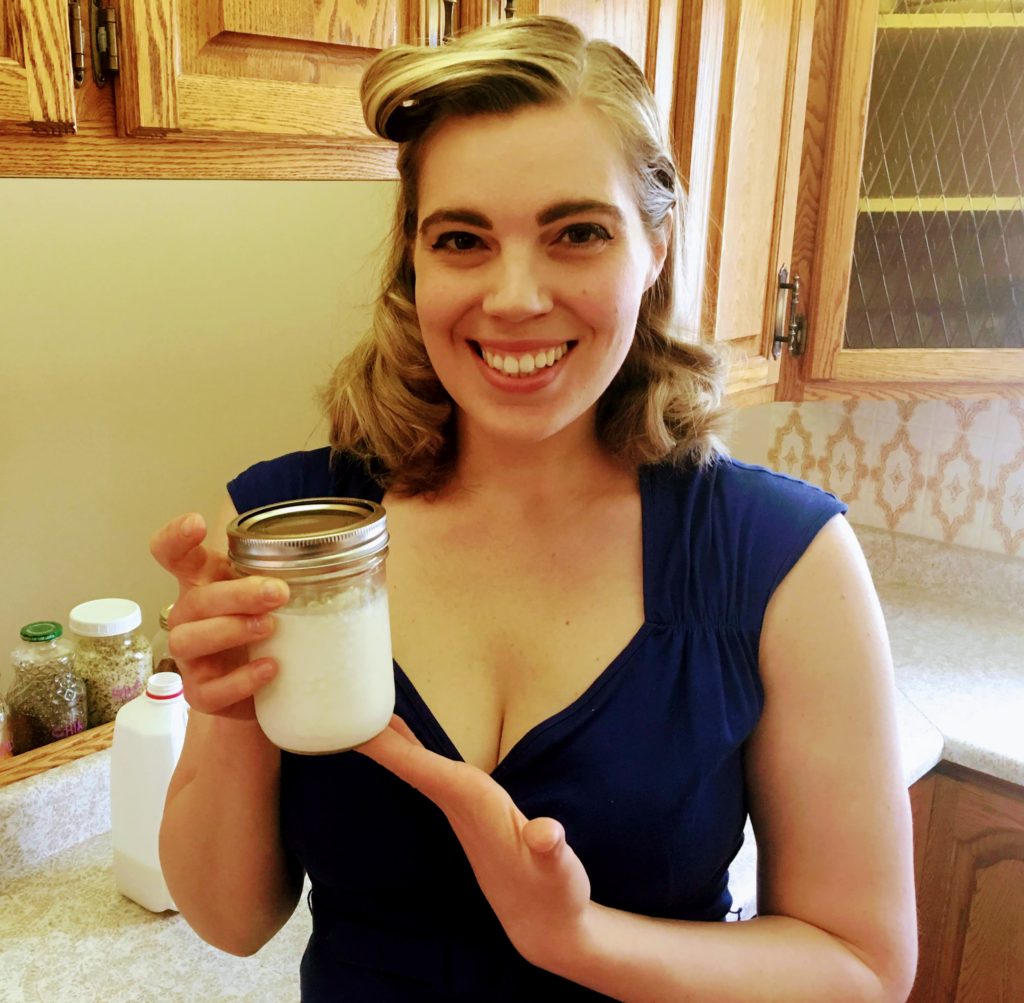
MAKING YOUR OWN MILK KEFIR
You may have noticed kefir in the dairy section at the grocery store stashed beside the goat milk.
It’s a fermented, gut-healthy probiotic drink that is slowly gaining in popularity but still has a long way to go.
When bought at full price (compared to making your own at home) the cost can be slightly prohibitive for a non-essential grocery item.
Even if it was more affordable, commercial kefir tastes nothing like the homemade version.
The kefir that I make at home is akin to drinking yogurt in liquid form.
It’s a thicker, tangier version of buttermilk, but oh, so much better.
When it comes to probiotics, it kicks yogurt’s butt, making it a daily go-to beverage for optimal gut health.
I’m not going to focus on kefir’s many virtues in this post, but if you’re curious, you can find a good summary of its health benefits on Healthline.
A VIDEO ON HOW TO MAKE MILK KEFIR
Here’s a little video tutorial showing you how to make your own milk kefir at home. If you like my vintage kitchen vibe, I hope you’ll subscribe to my YouTube channel!
This article may contain affiliate links, meaning that if you choose to purchase something after clicking on one of the links in this post, I may earn a small commission at no additional cost to you.
RELATED: How to Make Your Own Beet Kvass
RELATED: An Easy Beginner’s Guide to Making Sauerkraut
WHERE DO I FIND MILK KEFIR GRAINS?
First off, you will need to get your hands on some milk kefir grains.
These are not to be confused with water kefir grains, as they are two completely different cultures.
Where can you find these?
Find a friend who makes their own kefir, enquire at your local health food store, or order some online.
If you run a search on Kijiji, you’ll likely find someone selling their extra grains for a few bucks.
MAKING MILK KEFIR
Making milk kefir is one of the simplest things you can do.
When I was a kid, one of my dad’s nighttime rituals was retrieving his delegated mason jar from the lower kitchen cabinet.
Unscrewing the lid, my father would dump the contents into a fine-mesh sieve perched over a bowl and work a spoon around the grains, scraping the liquid through the sieve.
Then he’d divide the milky prize into three tumblers, adding a spoonful of cod liver oil to each.
Smart!
My brother and I were clueless. The tangy goodness masks the fishy tonic many a child has hidden away from!
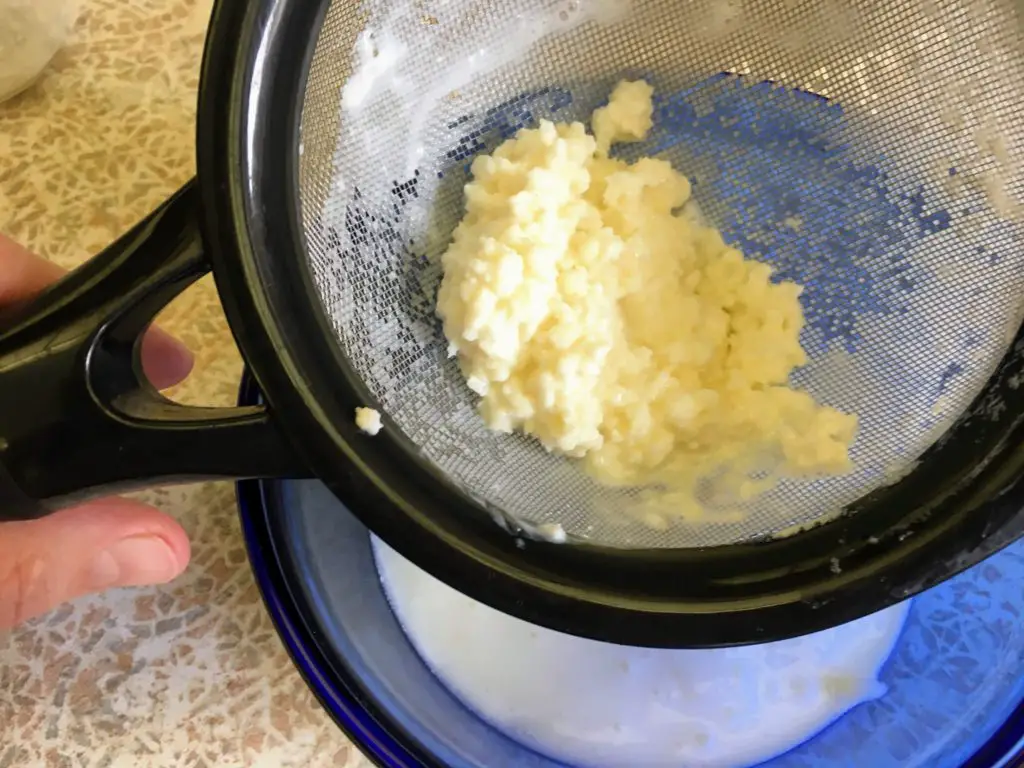
STEPS TO MAKING KEFIR
Pour the contents from your designated vessel into a fine mesh sieve over a medium sized bowl.Work a spoon around the sieve until all the liquid has passed through and only the grains remain.Wash and dry the designated kefir vessel.Scoop the grains back in the jar and top off with 3.25% milk.Loosely cover the jar and store in a dark place.
HOW MUCH MILK SHOULD I ADD WHEN MAKING KEFIR?
The amount of milk you add to your kefir grains really depends on how much kefir you want to drink.
If you can only commit to drinking a cup of kefir a day, then add a cup of milk.
It’s one of those things you can eyeball, so don’t overthink it too much. I usually fill my pint jar three-quarters full.
If you add too much milk, you’re not going to mess up your kefir, I promise! You might have to let it ferment for an extra day, but with time and experimentation, you’ll discover what works for you.
Chin up, it’s kefir, not rocket science!
HOW LONG SHOULD MY MILK KEFIR FERMENT?
The rule of thumb for kefir fermentation is 12 to 24 hours.
I personally let mine ferment for 36-48 hours because I like the extra tangy flavour, but, at the very least, kefir needs a full day for the grains’ lactic acid bacteria to work its magic.
The longer the ferment, the tangier it’s going to be.
WHAT DO I DO IF I FORGET ABOUT MY JAR OF KEFIR?
It happens. Sometimes life gets in the way or you go away on vacation and you come back to an unhappy jar of milk and culture.
When this happens, dump the lot into your trusty sieve and get all the liquid out.
I would advise against drinking it.
Once this is done, rinse the grains under cold, filtered water, and proceed with making kefir as you normally would.
It will take a couple of weeks for your kefir to bounce back from the dead, but your patience will be rewarded, I promise!
With that being said, if you’re going away on vacation, remember to store your kefir jar in the fridge.
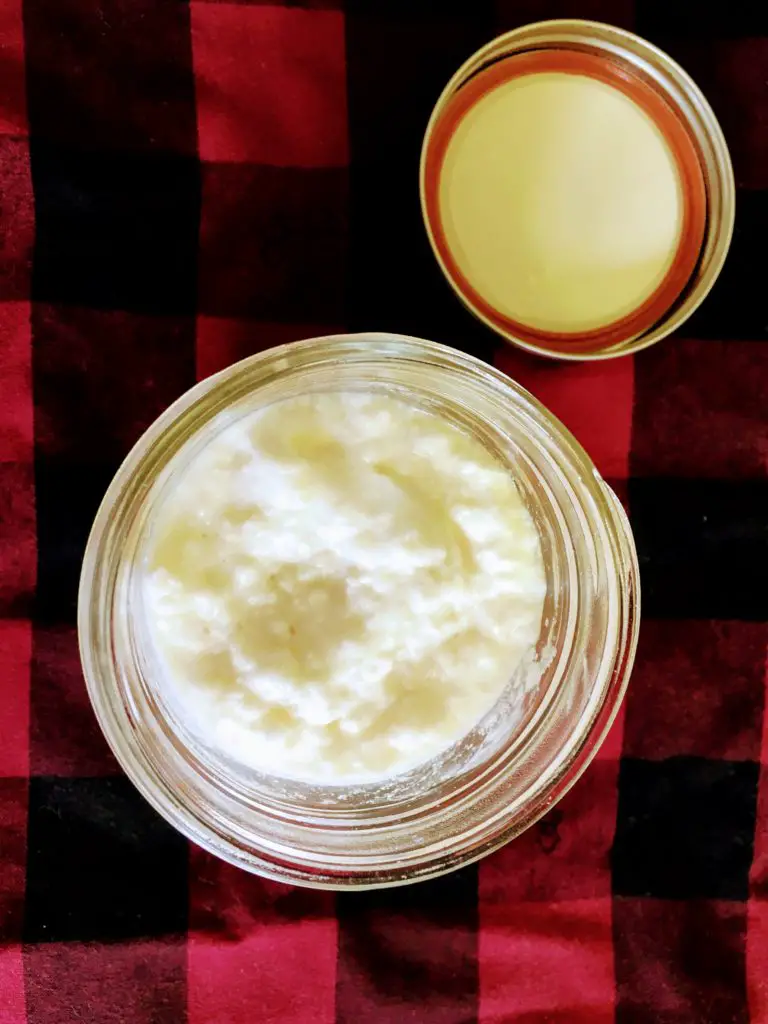
WHAT DO I DO WITH MY KEFIR?
Now that you have an abundance of milk kefir, what do you do with it?
Well, you can drink it for starters, or use it to trick your kids into taking a dose of cod liver oil, but the gamut doesn’t stop there.
Here are a few ideas to get the imagination running:
Add it to your morning smoothie instead of yogurt.
Use it in place of buttermilk and make kefir pancakes, waffles, and cornbread.
Bake with it. Kefir breakfast biscuits and kefir flour tortillas are two easy recipes to try out.
When fermenting steel cut oats or making a batch of regular overnight oats, sneak in a couple of tablespoons of kefir for a lacto-fermentation.
Use it as an ingredient in salad dressings. A homemade kefir ranch or a chipotle lime dressing would be delicious.
Play with it in your favourite recipes for popsicles. Mango lassi pops, anyone?
Brine chicken with kefir. You won't go back!
Create a secondary fermentation. Infuse freshly strained kefir with mango, crushed raspberries, or vanilla bean to take your kefir to a whole new level. Experiment with different flavours and let me know how it goes!
THINGS TO KEEP IN MIND WHEN MAKING MILK KEFIR
Kefir expands as the culture grows. Make sure you leave a bit of room in your kefir vessel to avoid an overflow.You can store kefir in the fridge for up to two weeks.If you're lucky enough to have access to raw milk, your kefir grains will grow like crazy. With that being said, your kefir will be just fine if all you can get your hands on is pasteurized milk. The grains will be even happier if it's organic pasteurized milk!
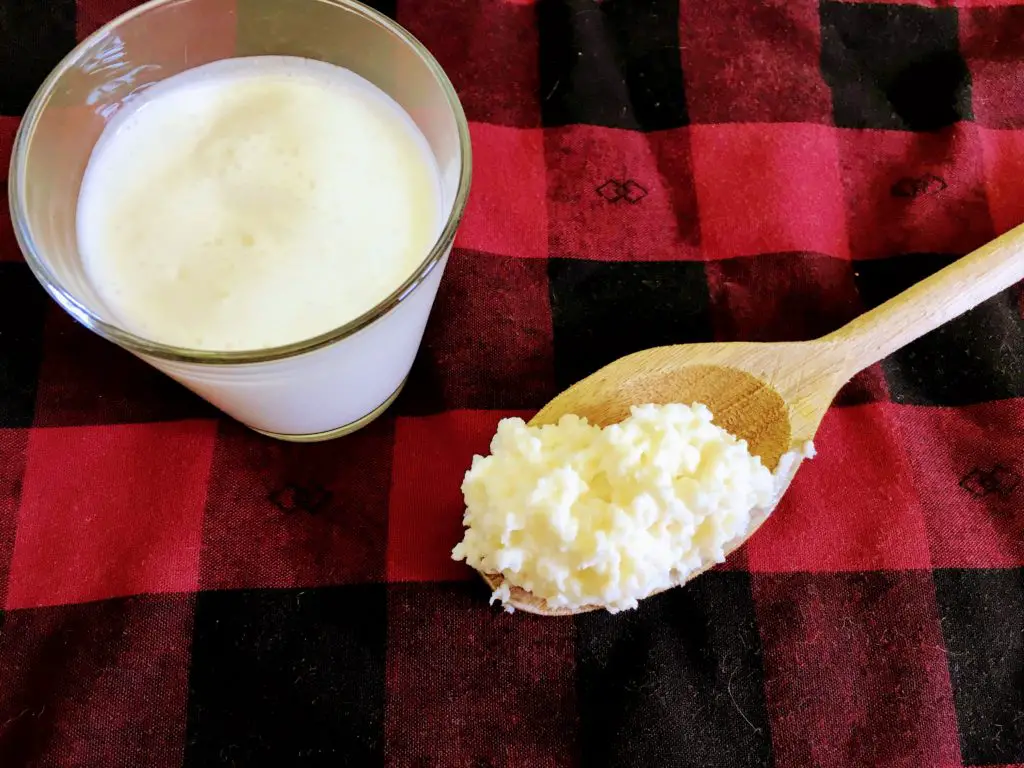
FUN FACTS ABOUT KEFIR
In addition to milk kefir, there's also water kefir which is usually made with coconut water or fruit juice.For the vegetarians in the house, kefir contains vitamin B12.Euphemisms for kefir grains include Tibetan mushrooms, snow lotus, and yogurt plant.Kefir is kind to the lactose-intolerant.
SHOP THIS POST
MILK KEFIR RECIPES TO TEST OUT
Making pancakes with milk kefir
Veggie platter with kefir ranch dip
PIN IT FOR LATER
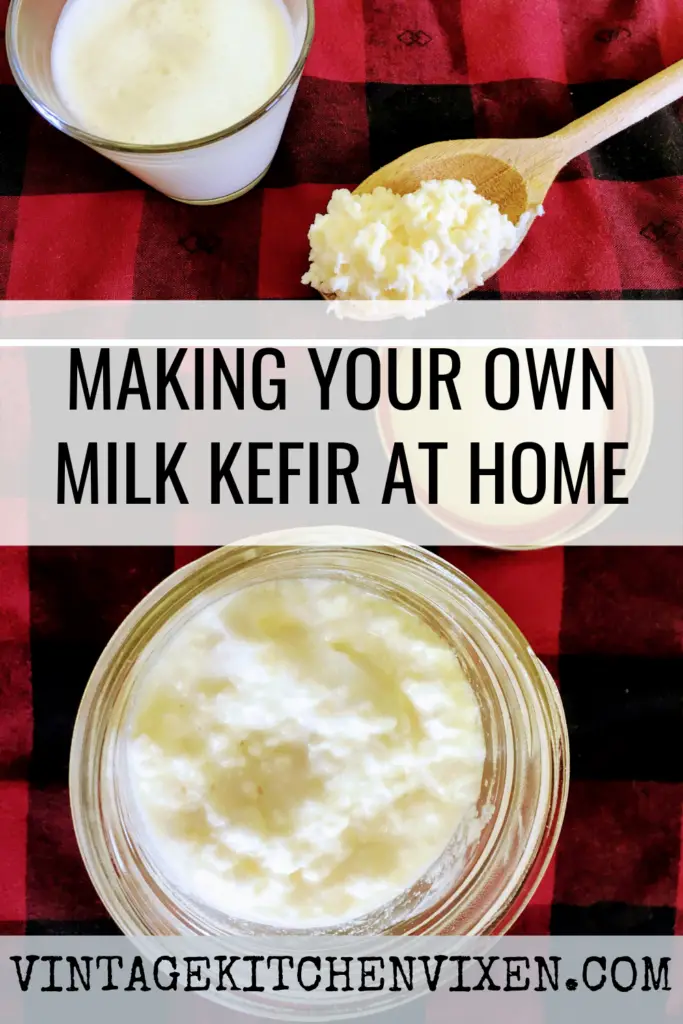
Love and gratitude,


Very thorough post on kefir! So neat that your dad fed you such nutritious foods! What a great start!
I have never tried milk Kiefer before. I’m excited to see if I can do this. I’ve always used a lot of buttermilk and a lot of my recipes but this looks like it might be a really good option as well. Thanks for this great post!
I love buttermilk! I used to love drinking it as a kid, but I rarely buy it because I usually have milk kefir I can use instead. P.S. You can 100% do this, Jen! Kefir is sooo easy to maintain! You just need to remember to refresh it daily or every other day.
I’ve always wanted to try and make this. Thank you for the information post. I can’t wait to try and make some. My daughter loves it! I know she will enjoy to make some at home.
Great post on kefir! That is so awesome you grew up with kefir in your household. It is truly the champagne of dairy. Your directions are detailed and easy to understand. Thank you for sharing! I love the name of your blog.
Thank you so much, Caren, that’s so sweet of you to say! If it weren’t for my dad I would probably have no idea what milk kefir is, so I consider myself lucky!
You should get yourself some culture and get started! My son loves kefir, too. It’s so funny watching him run around with a milk kefir mustache, lol.
Loved this informative post! And you’re such an encourager — love that. I mean, who needs rocket science in the kitchen anyway? lol
We make water kefir in our house. I wonder how milk kefir compares to yogurt? I’ve always stuck to making yogurt since it seemed simpler to me and I didn’t want another ferment to keep up on. What are your thoughts?
I really want to start making water kefir this year! It seems easier than kombucha (which I love, but I’m still a bit intimidated).
Milk kefir has the consistency of buttermilk, so it’s a lot thinner than yogurt, but it also has more probiotics. I usually always have yogurt on hand (I don’t go through enough to warrant making my own at this time) because they both have their own value.
I use milk kefir in a lot of recipes that I wouldn’t use yogurt for. While I do drink my kefir and use it in smoothies, I appreciate a good bowl of yogurt and its thickness. I would at least try it out for a couple of weeks to see if it’s something you want to keep up with. If you don’t think it’s worth the time (or if you don’t use it), you can always move on 🙂
I love kefir but in the past, mine had more of a yeasty flavor than I liked. I could not figure out how to get more tang and less yeast, even after talking to the people at Cultures for Health. Do you have any idea?
The culture needs a healthy balance of yeast and bacteria, so it sounds like a yeast imbalance! Were you keeping your kefir in a warm spot? Kefir does well at room temperature, but one thing to note is that bacteria do better in cooler temps and yeast thrives the warmer it gets. The other thing you could have done is to introduce new healthy bacteria to your kefir brew. I would never be able to do this because I’m in Canada, but feeding it with raw milk every so often is something milk kefir loves.
The only other thing I can think of is where you were storing your kefir. I know with kombucha, you have to be careful not to keep it near other ferments because they can cross-contaminate each other. You weren’t keeping your kefir near your sourdough starter, were you? I hope this helps and that you give it another go in the near future!
P.S. I would check out this article on Kombucha Home. They wrote a very thorough post on rebalancing yeasty milk kefir grains http://kombuchahome.com/make-kefir-taste-less-yeasty/.
I can’t wait to get the ebook! I thought I did this. I love your stories!What a great way to start a little life!
The sour cherry kefir smoothie is the best. I really wish I had some frozen cherries on hand because I would totally make it right now!
Interesting! I didn’t know you could bring it back to life, but live bacteria always amazes me. Thanks for sharing!
So I started a batch of my own Kafir a few weeks ago but the milk is always so sour and tangy I can’t bring myself to drink it. Makes me think it’s spoiled, even though I know it’s not. I’ve also tried rinsing my grains and started many new cups of milk hoping it would take down.. but I feel like it’s nothing like the kefir I buy at the store. I’m puzzled. I’ve also made sure after learning through mistakes to not let it over ferment by not letting it sit out to long and putting it in the fridge to slow down. Am I doomed? Is it just a bad batch of grains I got? Or am I missing something?
Sorry for the late reply! How long are you letting it ferment for? I wouldn’t let it ferment more than a day if it’s too tangy for you. I’ve never had to buy store bought kefir, so I don’t know how big of a difference it is, but you should be able to drink it. Where did you get your grains from? I’ve tried buying dehydrated grains before and prefer starting with a fresh culture as it takes a couple of weeks to activate the dehydrated grains. I hope you’ve been able to figure it out. Don’t give up hope!